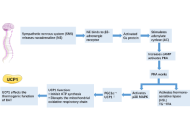

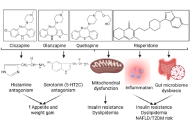

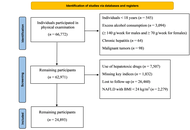
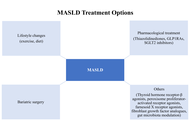

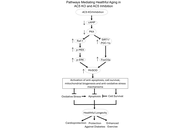
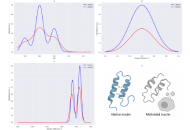
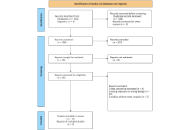

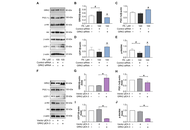



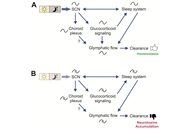


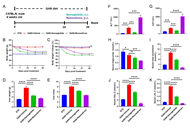
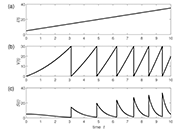

Glucagon-like peptide-1 (GLP-1) receptor agonists (GLP-1RAs) and dual incretin agonists have demonstrated significant potential in improving adipose tissue function beyond their established effects on appetite suppression and weight loss. These agents not only reduce overall fat mass but also induce favorable changes in fat distribution and adipose tissue quality. Notably, they enhance brown adipose tissue (BAT) activity and promote the browning of white adipose tissue (WAT), thereby increasing energy expenditure. They are associated with reductions in adipocyte size, particularly within visceral fat depots, alongside improvements in metabolic health markers. The aim of this publication is to provide a literature review on the effects of GLP-1RAs and dual incretin agonists on adipocyte type and size, adipose tissue functional remodeling, and their implications for obesity management. These findings highlight the capacity of incretin-based therapies to modulate adipose tissue biology, offering metabolic benefits that extend beyond weight reduction.
Glucagon-like peptide-1 (GLP-1) receptor agonists (GLP-1RAs) and dual incretin agonists have demonstrated significant potential in improving adipose tissue function beyond their established effects on appetite suppression and weight loss. These agents not only reduce overall fat mass but also induce favorable changes in fat distribution and adipose tissue quality. Notably, they enhance brown adipose tissue (BAT) activity and promote the browning of white adipose tissue (WAT), thereby increasing energy expenditure. They are associated with reductions in adipocyte size, particularly within visceral fat depots, alongside improvements in metabolic health markers. The aim of this publication is to provide a literature review on the effects of GLP-1RAs and dual incretin agonists on adipocyte type and size, adipose tissue functional remodeling, and their implications for obesity management. These findings highlight the capacity of incretin-based therapies to modulate adipose tissue biology, offering metabolic benefits that extend beyond weight reduction.
DOI: https://doi.org/10.37349/eemd.2025.101452

The glucocorticoid receptor alpha (GRα) is traditionally viewed as a stress-response element with anti-inflammatory properties. Mechanistically, convergent evidence from global and tissue-specific knockout models, translational clinical studies, and evolutionary analyses indicates that GRα’s vital role in maintaining systemic homeostasis challenges its peripheral classification in clinical medicine. To reconceptualize GRα as a master regulator of organismal survival by analyzing its non-redundant, multisystemic functions and evaluating its relevance in health, development, and critical illness. This narrative synthesis combines structured searches performed using the Consensus AI research platform with evidence from genetic knockout models, tissue-specific deletion studies, and translational clinical research. Key findings are framed within comparative receptor analyses and integrated into broader physiological models of homeostasis and allostasis. Evolutionarily, global loss of GRα is perinatally lethal, characterized by failure of lung maturation and respiratory adaptation, accompanied by metabolic and neuroendocrine dysregulation. Tissue-specific deletions reveal essential roles in immune regulation, mitochondrial bioenergetics, cardiovascular function, and neuroendocrine stability. While several other receptors (including MR) are also essential for survival, GRα is distinctive for the breadth of cross-system coordination it provides. GRα exhibits both genomic and non-genomic actions that support rapid stress adaptation and promote restoration of systemic stability. Clinically, despite this broad integrative role, GRα’s survival-critical functions remain underrecognized in therapeutic strategies. Overall, the evidence supports GRα as a central integrator of postnatal survival, metabolic resilience, and immunological competence. GRα is a vital receptor whose systemic regulatory functions exceed its historical classification as a stress hormone mediator. Its role is not ancillary but foundational, anchoring survival across immune, metabolic, cardiovascular, and neuroendocrine systems. The collapse of this receptor’s function is not simply a component of disease—it is the tipping point that drives the organism from adaptation toward systemic breakdown. Recognizing GRα as a master survival receptor redefines therapeutic priorities, guiding biomarker-driven restoration of homeostasis in critical illness.
The glucocorticoid receptor alpha (GRα) is traditionally viewed as a stress-response element with anti-inflammatory properties. Mechanistically, convergent evidence from global and tissue-specific knockout models, translational clinical studies, and evolutionary analyses indicates that GRα’s vital role in maintaining systemic homeostasis challenges its peripheral classification in clinical medicine. To reconceptualize GRα as a master regulator of organismal survival by analyzing its non-redundant, multisystemic functions and evaluating its relevance in health, development, and critical illness. This narrative synthesis combines structured searches performed using the Consensus AI research platform with evidence from genetic knockout models, tissue-specific deletion studies, and translational clinical research. Key findings are framed within comparative receptor analyses and integrated into broader physiological models of homeostasis and allostasis. Evolutionarily, global loss of GRα is perinatally lethal, characterized by failure of lung maturation and respiratory adaptation, accompanied by metabolic and neuroendocrine dysregulation. Tissue-specific deletions reveal essential roles in immune regulation, mitochondrial bioenergetics, cardiovascular function, and neuroendocrine stability. While several other receptors (including MR) are also essential for survival, GRα is distinctive for the breadth of cross-system coordination it provides. GRα exhibits both genomic and non-genomic actions that support rapid stress adaptation and promote restoration of systemic stability. Clinically, despite this broad integrative role, GRα’s survival-critical functions remain underrecognized in therapeutic strategies. Overall, the evidence supports GRα as a central integrator of postnatal survival, metabolic resilience, and immunological competence. GRα is a vital receptor whose systemic regulatory functions exceed its historical classification as a stress hormone mediator. Its role is not ancillary but foundational, anchoring survival across immune, metabolic, cardiovascular, and neuroendocrine systems. The collapse of this receptor’s function is not simply a component of disease—it is the tipping point that drives the organism from adaptation toward systemic breakdown. Recognizing GRα as a master survival receptor redefines therapeutic priorities, guiding biomarker-driven restoration of homeostasis in critical illness.
DOI: https://doi.org/10.37349/eemd.2025.101451

Psychiatric medication is vital in the treatment of a wide range of mental and behavioral health conditions, but has moderate metabolic consequences. The common side effects are weight gain, dyslipidemia, increased adiposity, elevated body mass index, increased insulin resistance, and metabolic alterations. Metabolic risk is lower with antidepressants than with antipsychotics. The side effects are linked to the metabolic syndrome, increasing the risk of heart disease, stroke, and type 2 diabetes. Cardiovascular diseases, dysglycemia and diabetes, atherogenic dyslipidemia, and metabolic syndrome are common complications associated with the use of antipsychotics. Therefore, it is essential to comprehend the metabolic alterations and develop strategies for early detection and intervention to mitigate these effects. This review discusses the metabolic alterations associated with common antipsychotic medications, followed by strategies to attenuate the effects.
Psychiatric medication is vital in the treatment of a wide range of mental and behavioral health conditions, but has moderate metabolic consequences. The common side effects are weight gain, dyslipidemia, increased adiposity, elevated body mass index, increased insulin resistance, and metabolic alterations. Metabolic risk is lower with antidepressants than with antipsychotics. The side effects are linked to the metabolic syndrome, increasing the risk of heart disease, stroke, and type 2 diabetes. Cardiovascular diseases, dysglycemia and diabetes, atherogenic dyslipidemia, and metabolic syndrome are common complications associated with the use of antipsychotics. Therefore, it is essential to comprehend the metabolic alterations and develop strategies for early detection and intervention to mitigate these effects. This review discusses the metabolic alterations associated with common antipsychotic medications, followed by strategies to attenuate the effects.
DOI: https://doi.org/10.37349/eemd.2025.101450
This article belongs to the special issue Regulators of Glucose Homeostasis, Lipid Metabolism and Energy Balance

In this Commentary, we highlight the following issues concerning the development of increasingly more powerful incretin-based therapeutics (IBT) that to date have not been addressed with the attention they may deserve: 1. The appropriateness of BMI-based inclusion criteria for a drug capable of producing weight loss approaching that seen after bariatric surgery; 2. significant limitations inherent in communicating the results of an obesity trial involving a potent IBT; 3. the one-size-fits-all dosing strategies in trials may introduce new challenges for sponsors in the race to develop increasingly powerful IBT; 4. the currently imposed limitations on what can be communicated in the approved IBT product label create an advantageously unlevel playing field for opportunists such as compounding pharmacies. Proposals on how to address these issues are made in the text. While it is realized that the presented topics and solutions are not without controversy, they are intended to provoke further discussion.
In this Commentary, we highlight the following issues concerning the development of increasingly more powerful incretin-based therapeutics (IBT) that to date have not been addressed with the attention they may deserve: 1. The appropriateness of BMI-based inclusion criteria for a drug capable of producing weight loss approaching that seen after bariatric surgery; 2. significant limitations inherent in communicating the results of an obesity trial involving a potent IBT; 3. the one-size-fits-all dosing strategies in trials may introduce new challenges for sponsors in the race to develop increasingly powerful IBT; 4. the currently imposed limitations on what can be communicated in the approved IBT product label create an advantageously unlevel playing field for opportunists such as compounding pharmacies. Proposals on how to address these issues are made in the text. While it is realized that the presented topics and solutions are not without controversy, they are intended to provoke further discussion.
DOI: https://doi.org/10.37349/eemd.2025.101449
This article belongs to the special issue Regulators of Glucose Homeostasis, Lipid Metabolism and Energy Balance

Aim:
To investigate the natural history and progression of non-alcoholic fatty liver disease (NAFLD) in Chinese adults using a community-based longitudinal cohort.
Methods:
We analyzed data from 24,893 adults in the Beijing Health Management Cohort (2016–2021) with annual follow-up, including questionnaires, physical examinations, and laboratory tests. Participants were categorized into three states: healthy (S1, n = 17,906), NAFLD with body mass index (BMI) < 24 kg/m2 (S2, n = 1,139), and NAFLD with BMI ≥ 24 kg/m2 (S3, n = 5,848). Transition probabilities, mean sojourn times, and determinants of progression were estimated using a multi-state Markov model, with analyses stratified by sex.
Results:
Most individuals remained in their baseline state. Females in S1 were more likely to stay healthy than males (93.76% vs. 83.52%), while males had a higher risk of progression to S3 (12.59% vs. 4.23%). Females in S3 had a greater chance of reverting to S1 (21.33% vs. 18.18%). Mean sojourn time in S1 was longer for females (18.58 vs. 6.97 years), whereas males spent more time in S3 (5.37 vs. 4.18 years). Age, hyperuricemia, abdominal obesity, high triglycerides, and low high-density lipoprotein cholesterol (HDL-C) significantly increased the risk of progression.
Conclusions:
Sex differences strongly affect NAFLD progression in Chinese adults. Males are more likely to deteriorate, while females show higher recovery. Metabolic factors and obesity are key targets for early prevention and intervention.
Aim:
To investigate the natural history and progression of non-alcoholic fatty liver disease (NAFLD) in Chinese adults using a community-based longitudinal cohort.
Methods:
We analyzed data from 24,893 adults in the Beijing Health Management Cohort (2016–2021) with annual follow-up, including questionnaires, physical examinations, and laboratory tests. Participants were categorized into three states: healthy (S1, n = 17,906), NAFLD with body mass index (BMI) < 24 kg/m2 (S2, n = 1,139), and NAFLD with BMI ≥ 24 kg/m2 (S3, n = 5,848). Transition probabilities, mean sojourn times, and determinants of progression were estimated using a multi-state Markov model, with analyses stratified by sex.
Results:
Most individuals remained in their baseline state. Females in S1 were more likely to stay healthy than males (93.76% vs. 83.52%), while males had a higher risk of progression to S3 (12.59% vs. 4.23%). Females in S3 had a greater chance of reverting to S1 (21.33% vs. 18.18%). Mean sojourn time in S1 was longer for females (18.58 vs. 6.97 years), whereas males spent more time in S3 (5.37 vs. 4.18 years). Age, hyperuricemia, abdominal obesity, high triglycerides, and low high-density lipoprotein cholesterol (HDL-C) significantly increased the risk of progression.
Conclusions:
Sex differences strongly affect NAFLD progression in Chinese adults. Males are more likely to deteriorate, while females show higher recovery. Metabolic factors and obesity are key targets for early prevention and intervention.
DOI: https://doi.org/10.37349/eemd.2025.101448

Fatty liver, defined as lipid accumulation in more than 5% of hepatocytes, has become an increasingly important contributor to liver cirrhosis, particularly as viral hepatitis is being brought under control through vaccination and antiviral therapies. Abdominal obesity and insulin resistance play a central role in its pathogenesis. The global burden of metabolic dysfunction-associated steatotic liver disease (MASLD), formerly known as nonalcoholic fatty liver disease (NAFLD), continues to rise in parallel with the increasing prevalence of obesity and type 2 diabetes mellitus (T2DM). While meta-analyses indicate that the overall worldwide prevalence of MASLD is approximately 30%, higher rates have been reported in regions such as Latin America and North America. Among individuals with T2DM, the prevalence may reach up to 65%, and MASLD in these patients frequently progresses to metabolic dysfunction-associated steatohepatitis (MASH) and advanced fibrosis. Shared pathogenic mechanisms—most notably insulin resistance and chronic low-grade inflammation—drive disease progression, contributing to increased morbidity and mortality. The bidirectional relationship is further underscored by the observation that MASLD itself predisposes to the development of T2DM. In addition, the coexistence of MASLD and T2DM may exert a synergistic effect on cardiovascular disease (CVD) risk, and emerging evidence suggests that MASLD may represent an independent risk factor for CVD. Consequently, individuals with both MASLD and T2DM should be recognized as a particularly high-risk population requiring comprehensive monitoring of both hepatic and cardiovascular health. In this review, we aim to provide a concise overview of the etiopathogenesis, diagnostic approaches, and therapeutic strategies related to the MASLD-T2DM interface, a global health challenge that can be regarded as a pandemic of modern times.
Fatty liver, defined as lipid accumulation in more than 5% of hepatocytes, has become an increasingly important contributor to liver cirrhosis, particularly as viral hepatitis is being brought under control through vaccination and antiviral therapies. Abdominal obesity and insulin resistance play a central role in its pathogenesis. The global burden of metabolic dysfunction-associated steatotic liver disease (MASLD), formerly known as nonalcoholic fatty liver disease (NAFLD), continues to rise in parallel with the increasing prevalence of obesity and type 2 diabetes mellitus (T2DM). While meta-analyses indicate that the overall worldwide prevalence of MASLD is approximately 30%, higher rates have been reported in regions such as Latin America and North America. Among individuals with T2DM, the prevalence may reach up to 65%, and MASLD in these patients frequently progresses to metabolic dysfunction-associated steatohepatitis (MASH) and advanced fibrosis. Shared pathogenic mechanisms—most notably insulin resistance and chronic low-grade inflammation—drive disease progression, contributing to increased morbidity and mortality. The bidirectional relationship is further underscored by the observation that MASLD itself predisposes to the development of T2DM. In addition, the coexistence of MASLD and T2DM may exert a synergistic effect on cardiovascular disease (CVD) risk, and emerging evidence suggests that MASLD may represent an independent risk factor for CVD. Consequently, individuals with both MASLD and T2DM should be recognized as a particularly high-risk population requiring comprehensive monitoring of both hepatic and cardiovascular health. In this review, we aim to provide a concise overview of the etiopathogenesis, diagnostic approaches, and therapeutic strategies related to the MASLD-T2DM interface, a global health challenge that can be regarded as a pandemic of modern times.
DOI: https://doi.org/10.37349/eemd.2025.101446
This article belongs to the special issue Current Views on Pathogenesis, Diagnosis and Management of Type 2 Diabetes Mellitus and Its Complications and Related Conditions

Hormonal dysregulation plays a central role in aging, exerting a profound, multidimensional impact on quality of life. This narrative review examines the impact of hormonal changes in understanding how age-dependent alterations in key hormonal axes, specifically those related to insulin, IGF-1, cortisol, thyroid hormones, parathyroid hormone, and sex hormones, affect metabolic, musculoskeletal, cognitive, and reproductive health. Altered hormone secretion and receptor sensitivity contribute to conditions such as type 2 diabetes mellitus, osteoporosis, sarcopenia, cognitive decline, and disrupted sleep patterns. Age-related shifts in thyroid and parathyroid function, including decreased T3 conversion and elevated PTH, further compound these physiological changes. These hormonal imbalances manifest as a multidimensional burden on quality of life, encompassing physical, cognitive, and psychosocial domains, which are particularly pronounced in postmenopausal women. Emerging therapies targeting GH secretion, myostatin inhibition, heat shock proteins, and IGF-1 offer promising avenues for mitigating age-associated symptoms and improving quality of life.
Hormonal dysregulation plays a central role in aging, exerting a profound, multidimensional impact on quality of life. This narrative review examines the impact of hormonal changes in understanding how age-dependent alterations in key hormonal axes, specifically those related to insulin, IGF-1, cortisol, thyroid hormones, parathyroid hormone, and sex hormones, affect metabolic, musculoskeletal, cognitive, and reproductive health. Altered hormone secretion and receptor sensitivity contribute to conditions such as type 2 diabetes mellitus, osteoporosis, sarcopenia, cognitive decline, and disrupted sleep patterns. Age-related shifts in thyroid and parathyroid function, including decreased T3 conversion and elevated PTH, further compound these physiological changes. These hormonal imbalances manifest as a multidimensional burden on quality of life, encompassing physical, cognitive, and psychosocial domains, which are particularly pronounced in postmenopausal women. Emerging therapies targeting GH secretion, myostatin inhibition, heat shock proteins, and IGF-1 offer promising avenues for mitigating age-associated symptoms and improving quality of life.
DOI: https://doi.org/10.37349/eemd.2025.101447
This article belongs to the special issue The Fountain of Youth: Decoding the Hormonal Regulation of Aging

Adenylyl cyclase 5 knockout (AC5 KO) is a healthful longevity model; not only do the AC5 KO mice live a third longer than wild-type (WT) mice, but they are also protected against obesity, diabetes, heart failure, and exercise intolerance, mediated by anti-apoptosis, cell survival, myocardial biogenesis, and anti-oxidative stress mechanisms. To translate these salutary effects to the clinics, we developed a drug, C90, which recapitulates the AC5 KO model of healthful longevity. We then examined its effects on glucose tolerance and exercise capacity. C90 (30 mg/kg/day) or vehicle was chronically administered to age-matched C57BL/6 mice via an osmotic pump. The WT mice receiving C90 exhibited improved glucose tolerance, following glucose i.v. injection, when compared to the vehicle. Furthermore, the C90-treated mice had a lower fasting glucose level when compared to the vehicle-treated mice (113 ± 6.5 mg/dL vs. 129 ± 4.2 mg/dL, p < 0.05). Additionally, the WT group that received C90 exhibited greater exercise capacity, reflected by longer running distance (384 ± 27 m vs. 253 ± 16 m, p < 0.05) and greater work to exhaustion (18.1 ± 1.5 J vs. 12.4 ± 0.7 J, p < 0.05) than mice receiving vehicle. In view of these findings, C90 is an excellent candidate for clinical development as an effective pharmacological treatment for glucose intolerance and enhancing exercise performance.
Adenylyl cyclase 5 knockout (AC5 KO) is a healthful longevity model; not only do the AC5 KO mice live a third longer than wild-type (WT) mice, but they are also protected against obesity, diabetes, heart failure, and exercise intolerance, mediated by anti-apoptosis, cell survival, myocardial biogenesis, and anti-oxidative stress mechanisms. To translate these salutary effects to the clinics, we developed a drug, C90, which recapitulates the AC5 KO model of healthful longevity. We then examined its effects on glucose tolerance and exercise capacity. C90 (30 mg/kg/day) or vehicle was chronically administered to age-matched C57BL/6 mice via an osmotic pump. The WT mice receiving C90 exhibited improved glucose tolerance, following glucose i.v. injection, when compared to the vehicle. Furthermore, the C90-treated mice had a lower fasting glucose level when compared to the vehicle-treated mice (113 ± 6.5 mg/dL vs. 129 ± 4.2 mg/dL, p < 0.05). Additionally, the WT group that received C90 exhibited greater exercise capacity, reflected by longer running distance (384 ± 27 m vs. 253 ± 16 m, p < 0.05) and greater work to exhaustion (18.1 ± 1.5 J vs. 12.4 ± 0.7 J, p < 0.05) than mice receiving vehicle. In view of these findings, C90 is an excellent candidate for clinical development as an effective pharmacological treatment for glucose intolerance and enhancing exercise performance.
DOI: https://doi.org/10.37349/eemd.2025.101445
This article belongs to the special issue Innovative Strategies for Diabetes and Metabolic Disorders: Current and Future Directions

Type 2 diabetes mellitus (T2DM), expected to exceed 700 million cases by 2045, is usually attributed to obesity and peripheral resistance but neglects insulin’s structural integrity. This review introduces the Sulfur-Insulin Deformation Hypothesis, positing T2DM as a sulfur metabolism disorder where mitochondrial suffocation disrupts the transsulfuration pathway [methionine to cysteine via cystathionine β-synthase (CBS) and γ-lyase (CGL)], depleting cysteine and glutathione (GSH), impairing protein disulfide isomerase (PDI) activity, and deforming insulin’s disulfide bonds (A6–A11, A7–B7, A20–B19) as a primary trigger of insulin resistance. A literature synthesis was conducted (1995–2025) across PubMed, Scopus, Web of Science, and Google Scholar, using Medical Subject Headings (MeSH) terms like “sulfur metabolism”, “insulin misfolding”, and “mitochondrial dysfunction”. From 1,202 articles, 113 studies were selected, including in vitro insulin folding models, animal metabolic stress data, human sulfur biomarker analyses, and trials of sulfur donors (e.g., N-acetylcysteine). Mitochondrial dysfunction reduces adenosine triphosphate (ATP), depleting cysteine and GSH by 30–73.8% (red blood cell GSH: 1.78 ± 0.28 µmol/g vs. 6.75 ± 0.47 µmol/g Hb, P < 0.001), elevating reactive oxygen species (ROS). This impairs PDI isoforms (PDIA1, PDIA3, PDIA4), disrupting insulin bonds; the A6–A11 bond loses 50–70% affinity [r = –0.65, P < 0.05 for homeostatic model assessment of insulin resistance (HOMA-IR)], hindering phosphoinositide 3-kinase-protein kinase B (PI3K-Akt) signaling and glucose transporter type 4 (GLUT4) translocation. In 225 T2DM patients, PDIA4 elevation correlated with glucose (r = 0.62, P < 0.01) and reduced sensitivity (r = –0.67, P < 0.01). PDIA4 inhibition [presenilin 1 (PS1), IC50 = 4 μM] cuts ROS by 50% (P < 0.01), lowers hemoglobin A1c (HbA1c) by 1.2% (P < 0.05), and boosts β-cell survival by 30% (P < 0.05). Redox-mediated chain splitting degrades 20% of insulin (0.40 nmol/kg/min) at –137 mV, modulated by GSH. The hypothesis redefines T2DM as a sulfur-driven structural disorder, unveiling the gut-mitochondria-sulfur-insulin axis and advocating sulfur-centric therapies (e.g., N-acetylcysteine, methylsulfonylmethane).
Type 2 diabetes mellitus (T2DM), expected to exceed 700 million cases by 2045, is usually attributed to obesity and peripheral resistance but neglects insulin’s structural integrity. This review introduces the Sulfur-Insulin Deformation Hypothesis, positing T2DM as a sulfur metabolism disorder where mitochondrial suffocation disrupts the transsulfuration pathway [methionine to cysteine via cystathionine β-synthase (CBS) and γ-lyase (CGL)], depleting cysteine and glutathione (GSH), impairing protein disulfide isomerase (PDI) activity, and deforming insulin’s disulfide bonds (A6–A11, A7–B7, A20–B19) as a primary trigger of insulin resistance. A literature synthesis was conducted (1995–2025) across PubMed, Scopus, Web of Science, and Google Scholar, using Medical Subject Headings (MeSH) terms like “sulfur metabolism”, “insulin misfolding”, and “mitochondrial dysfunction”. From 1,202 articles, 113 studies were selected, including in vitro insulin folding models, animal metabolic stress data, human sulfur biomarker analyses, and trials of sulfur donors (e.g., N-acetylcysteine). Mitochondrial dysfunction reduces adenosine triphosphate (ATP), depleting cysteine and GSH by 30–73.8% (red blood cell GSH: 1.78 ± 0.28 µmol/g vs. 6.75 ± 0.47 µmol/g Hb, P < 0.001), elevating reactive oxygen species (ROS). This impairs PDI isoforms (PDIA1, PDIA3, PDIA4), disrupting insulin bonds; the A6–A11 bond loses 50–70% affinity [r = –0.65, P < 0.05 for homeostatic model assessment of insulin resistance (HOMA-IR)], hindering phosphoinositide 3-kinase-protein kinase B (PI3K-Akt) signaling and glucose transporter type 4 (GLUT4) translocation. In 225 T2DM patients, PDIA4 elevation correlated with glucose (r = 0.62, P < 0.01) and reduced sensitivity (r = –0.67, P < 0.01). PDIA4 inhibition [presenilin 1 (PS1), IC50 = 4 μM] cuts ROS by 50% (P < 0.01), lowers hemoglobin A1c (HbA1c) by 1.2% (P < 0.05), and boosts β-cell survival by 30% (P < 0.05). Redox-mediated chain splitting degrades 20% of insulin (0.40 nmol/kg/min) at –137 mV, modulated by GSH. The hypothesis redefines T2DM as a sulfur-driven structural disorder, unveiling the gut-mitochondria-sulfur-insulin axis and advocating sulfur-centric therapies (e.g., N-acetylcysteine, methylsulfonylmethane).
DOI: https://doi.org/10.37349/eemd.2025.101444
This article belongs to the special issue Current Views on Pathogenesis, Diagnosis and Management of Type 2 Diabetes Mellitus and Its Complications and Related Conditions

Background:
Metabolic dysfunction-associated fatty liver disease (MAFLD) and type 2 diabetes mellitus (T2DM) frequently coexist, showing a bidirectional relationship. MAFLD increases the risk of T2DM, while T2DM independently raises the likelihood of MAFLD.
Methods:
A comprehensive review was carried out on recent systematic reviews and meta-analyses by searching databases including PubMed, Embase, Web of Science, and the Cochrane database of systematic reviews, covering studies from inception to February 2025. Additionally, manual searches of reference lists were conducted. Inclusion criteria involved systematic reviews and meta-analyses of randomized controlled trials (RCTs) evaluating treatment effects on health outcomes in individuals with T2DM and MAFLD.
Results:
The search yielded 19 meta-analyses and 112 health outcomes from 622 unique articles. Most analyses focused on treatment effects on endocrine metabolic outcomes (n = 28), lipid metabolic indicators (n = 26), liver health indicators (n = 34), and body composition indicators (n = 24). High-quality evidence indicates that high-intensity interval training improves insulin resistance and low-density lipoprotein cholesterol levels. High-quality evidence also indicates sodium-glucose cotransporter-2 (SGLT-2) inhibitors improved liver proton density fat fraction and fatty liver index, while glucagon-like peptide-1 receptor agonists (GLP-1RAs), particularly liraglutide, enhanced subcutaneous adipose tissue (SAT). Moderate-quality evidence shows that dipeptidyl peptidase-4 (DPP-4) inhibitors enhanced insulin resistance and GLP-1RAs benefited triglycerides, aspartate transaminase, liver fat, and visceral adipose tissue. SGLT-2 inhibitors improved controlled attenuation parameter, body mass index (BMI), SAT, visceral fat mass, and moderate-intensity continuous training improved triglycerides and high-density lipoprotein cholesterol. Fifty-six outcomes were rated as low-quality evidence, and five as very low-quality.
Discussion:
GLP-1RAs, SGLT-2 inhibitors, DPP-4 inhibitors, exercise, and Chinese Herbal Medicines benefited liver health, glycemic control in T2DM with MAFLD, and impacted body composition and lipid metabolism.
Background:
Metabolic dysfunction-associated fatty liver disease (MAFLD) and type 2 diabetes mellitus (T2DM) frequently coexist, showing a bidirectional relationship. MAFLD increases the risk of T2DM, while T2DM independently raises the likelihood of MAFLD.
Methods:
A comprehensive review was carried out on recent systematic reviews and meta-analyses by searching databases including PubMed, Embase, Web of Science, and the Cochrane database of systematic reviews, covering studies from inception to February 2025. Additionally, manual searches of reference lists were conducted. Inclusion criteria involved systematic reviews and meta-analyses of randomized controlled trials (RCTs) evaluating treatment effects on health outcomes in individuals with T2DM and MAFLD.
Results:
The search yielded 19 meta-analyses and 112 health outcomes from 622 unique articles. Most analyses focused on treatment effects on endocrine metabolic outcomes (n = 28), lipid metabolic indicators (n = 26), liver health indicators (n = 34), and body composition indicators (n = 24). High-quality evidence indicates that high-intensity interval training improves insulin resistance and low-density lipoprotein cholesterol levels. High-quality evidence also indicates sodium-glucose cotransporter-2 (SGLT-2) inhibitors improved liver proton density fat fraction and fatty liver index, while glucagon-like peptide-1 receptor agonists (GLP-1RAs), particularly liraglutide, enhanced subcutaneous adipose tissue (SAT). Moderate-quality evidence shows that dipeptidyl peptidase-4 (DPP-4) inhibitors enhanced insulin resistance and GLP-1RAs benefited triglycerides, aspartate transaminase, liver fat, and visceral adipose tissue. SGLT-2 inhibitors improved controlled attenuation parameter, body mass index (BMI), SAT, visceral fat mass, and moderate-intensity continuous training improved triglycerides and high-density lipoprotein cholesterol. Fifty-six outcomes were rated as low-quality evidence, and five as very low-quality.
Discussion:
GLP-1RAs, SGLT-2 inhibitors, DPP-4 inhibitors, exercise, and Chinese Herbal Medicines benefited liver health, glycemic control in T2DM with MAFLD, and impacted body composition and lipid metabolism.
DOI: https://doi.org/10.37349/eemd.2025.101443
This article belongs to the special issue Innovative Strategies for Diabetes and Metabolic Disorders: Current and Future Directions

Background:
Gestational diabetes mellitus (GDM), defined as glucose intolerance with onset or first recognition during pregnancy, poses a significant and growing public health challenge in India. With India housing the world’s largest diabetes population, the rising prevalence of GDM has profound implications for maternal and neonatal health, contributing to complications including preeclampsia, macrosomia, neonatal hypoglycaemia, and increased lifelong risk of type 2 diabetes mellitus (T2DM) for both mother and child.
Methods:
We conducted a systematic literature search of PubMed, Embase, Google Scholar, and Cochrane Library for studies published between January 2019 and December 2024, with seminal works from 2015–2018. Search terms included “gestational diabetes mellitus”, “India”, “screening”, “prevalence”, “management”, and “health systems”. Eligible studies included peer-reviewed articles, government reports, and systematic reviews focusing on Indian populations. Two reviewers independently screened and extracted data. The PRISMA 2020 framework guided reporting.
Results:
From 2,847 initial records, 156 studies met the inclusion criteria. GDM prevalence in India ranges from 7.2% to 21.4%, with substantial regional variations. Southern states consistently report higher prevalence (15–22%) compared to northern (10–17%) and eastern regions (8–15%). Key challenges identified include low awareness among pregnant women (32% rural, 58% urban) and healthcare providers, inconsistent adoption of evidence-based guidelines (41% of facilities following standardized protocols), severe resource and infrastructural constraints, and significant socioeconomic barriers. Laboratory facilities for oral glucose tolerance test (OGTT) are available in only 34% of community health centers and 12% of primary health centers. Digital health interventions show promise but face implementation barriers, including limited smartphone penetration (45% in rural areas) and inadequate Accredited Social Health Activist (ASHA) workforce training (34% completion rate).
Discussion:
Despite the escalating burden of GDM in India, numerous unmet needs persist across the care continuum. This review proposes actionable recommendations, including simplified, cost-effective screening strategies, capacity building, integration into existing maternal health programs, and robust postpartum follow-up systems. Success requires sustained commitment to collaborative research, policy initiatives, and integrated, equitable, and sustainable GDM care approaches.
Background:
Gestational diabetes mellitus (GDM), defined as glucose intolerance with onset or first recognition during pregnancy, poses a significant and growing public health challenge in India. With India housing the world’s largest diabetes population, the rising prevalence of GDM has profound implications for maternal and neonatal health, contributing to complications including preeclampsia, macrosomia, neonatal hypoglycaemia, and increased lifelong risk of type 2 diabetes mellitus (T2DM) for both mother and child.
Methods:
We conducted a systematic literature search of PubMed, Embase, Google Scholar, and Cochrane Library for studies published between January 2019 and December 2024, with seminal works from 2015–2018. Search terms included “gestational diabetes mellitus”, “India”, “screening”, “prevalence”, “management”, and “health systems”. Eligible studies included peer-reviewed articles, government reports, and systematic reviews focusing on Indian populations. Two reviewers independently screened and extracted data. The PRISMA 2020 framework guided reporting.
Results:
From 2,847 initial records, 156 studies met the inclusion criteria. GDM prevalence in India ranges from 7.2% to 21.4%, with substantial regional variations. Southern states consistently report higher prevalence (15–22%) compared to northern (10–17%) and eastern regions (8–15%). Key challenges identified include low awareness among pregnant women (32% rural, 58% urban) and healthcare providers, inconsistent adoption of evidence-based guidelines (41% of facilities following standardized protocols), severe resource and infrastructural constraints, and significant socioeconomic barriers. Laboratory facilities for oral glucose tolerance test (OGTT) are available in only 34% of community health centers and 12% of primary health centers. Digital health interventions show promise but face implementation barriers, including limited smartphone penetration (45% in rural areas) and inadequate Accredited Social Health Activist (ASHA) workforce training (34% completion rate).
Discussion:
Despite the escalating burden of GDM in India, numerous unmet needs persist across the care continuum. This review proposes actionable recommendations, including simplified, cost-effective screening strategies, capacity building, integration into existing maternal health programs, and robust postpartum follow-up systems. Success requires sustained commitment to collaborative research, policy initiatives, and integrated, equitable, and sustainable GDM care approaches.
DOI: https://doi.org/10.37349/eemd.2025.101442

Aim:
Baicalin and ginsenoside Rb1 show the ability to promote adipocyte browning, but their effects, especially combined treatment, and the related mechanisms under pathological conditions are less known. The study investigated the regulation of browning markers by baicalin and Rb1 under lipid overload and explored the potential implication of a serine/threonine protein kinase G protein-coupled receptor kinase 2 (GRK2).
Methods:
The 3T3-L1 cells under palmitic acid (PA) stimulation and male ICR mice on a high-fat diet (HFD) challenge were used to evaluate the effects of drugs.
Results:
GRK2 silencing and overexpression inversely regulated the protein abundance of PGC-1α and UCP-1 in 3T3-L1 adipocytes. Baicalin, Rb1, and their combination decreased the PA-induced elevation of GRK2 while increasing the thermogenetic markers at the protein and mRNA levels. In vivo, the tested drugs restored the expression of thermogenetic and mitochondrial biogenetic markers in the inguinal white adipose tissue (WAT) of HFD-fed mice. Consistently, the drug-treated mice displayed an improved metabolic profile. The baicalin-Rb1 combination showed a more potent effect in some examinations, and its effect was comparable to that of GRK2 inhibitor paroxetine or AMP-activated protein kinase activator metformin.
Conclusions:
Baicalin and Rb1, alone or in combination, improved the browning of adipocytes during differentiation and prevented the whitening shift of WAT on an HFD, which was associated with the downregulation of GRK2. The study expands the understanding of the anti-obesity effects of baicalin and Rb1 and the potential of Scutellariae Radix-Ginseng Radix et Rhizoma compatibility for treating obesity-associated metabolic diseases.
Aim:
Baicalin and ginsenoside Rb1 show the ability to promote adipocyte browning, but their effects, especially combined treatment, and the related mechanisms under pathological conditions are less known. The study investigated the regulation of browning markers by baicalin and Rb1 under lipid overload and explored the potential implication of a serine/threonine protein kinase G protein-coupled receptor kinase 2 (GRK2).
Methods:
The 3T3-L1 cells under palmitic acid (PA) stimulation and male ICR mice on a high-fat diet (HFD) challenge were used to evaluate the effects of drugs.
Results:
GRK2 silencing and overexpression inversely regulated the protein abundance of PGC-1α and UCP-1 in 3T3-L1 adipocytes. Baicalin, Rb1, and their combination decreased the PA-induced elevation of GRK2 while increasing the thermogenetic markers at the protein and mRNA levels. In vivo, the tested drugs restored the expression of thermogenetic and mitochondrial biogenetic markers in the inguinal white adipose tissue (WAT) of HFD-fed mice. Consistently, the drug-treated mice displayed an improved metabolic profile. The baicalin-Rb1 combination showed a more potent effect in some examinations, and its effect was comparable to that of GRK2 inhibitor paroxetine or AMP-activated protein kinase activator metformin.
Conclusions:
Baicalin and Rb1, alone or in combination, improved the browning of adipocytes during differentiation and prevented the whitening shift of WAT on an HFD, which was associated with the downregulation of GRK2. The study expands the understanding of the anti-obesity effects of baicalin and Rb1 and the potential of Scutellariae Radix-Ginseng Radix et Rhizoma compatibility for treating obesity-associated metabolic diseases.
DOI: https://doi.org/10.37349/eemd.2025.101441
This article belongs to the special issue Regulators of Glucose Homeostasis, Lipid Metabolism and Energy Balance

As women transition to menopause, their risk of cardiovascular disease increases. The risk is mediated by a cluster of abnormalities, the ‘metabolic syndrome’: dyslipidemia, insulin resistance, hypertension, and obesity. The risk is proportional to the duration of menopause, although ethnic differences were reported. Other contributing factors include estrogen deficiency, inflammatory markers, history of gestational diabetes mellitus, preeclampsia, and polycystic ovary syndrome. Susceptibility to metabolic syndrome is mediated by genetic and lifestyle factors. Intervention to prevent metabolic syndrome must begin early with physical exercise, proper nutrition, and, where indicated, nutritional supplements. Although initial results of the Women’s Health Initiative suggested that hormone therapy after menopause led to adverse outcomes, further studies, such as the Early versus Late Intervention Trial with Estradiol (ELITE) study and the Kronos Early Estrogen Prevention Study (KEEPS), showed cardiovascular benefits if hormone replacement is begun early in women not at high risk of cardiovascular disease. A personalized preventive approach must be applied.
As women transition to menopause, their risk of cardiovascular disease increases. The risk is mediated by a cluster of abnormalities, the ‘metabolic syndrome’: dyslipidemia, insulin resistance, hypertension, and obesity. The risk is proportional to the duration of menopause, although ethnic differences were reported. Other contributing factors include estrogen deficiency, inflammatory markers, history of gestational diabetes mellitus, preeclampsia, and polycystic ovary syndrome. Susceptibility to metabolic syndrome is mediated by genetic and lifestyle factors. Intervention to prevent metabolic syndrome must begin early with physical exercise, proper nutrition, and, where indicated, nutritional supplements. Although initial results of the Women’s Health Initiative suggested that hormone therapy after menopause led to adverse outcomes, further studies, such as the Early versus Late Intervention Trial with Estradiol (ELITE) study and the Kronos Early Estrogen Prevention Study (KEEPS), showed cardiovascular benefits if hormone replacement is begun early in women not at high risk of cardiovascular disease. A personalized preventive approach must be applied.
DOI: https://doi.org/10.37349/eemd.2025.101440
This article belongs to the special issue Metabolic Syndrome in Menopause

Background:
Emerging evidence suggests that genetic variations in taste receptor genes may influence dietary behaviors, energy homeostasis, and metabolic risk, contributing to type 2 diabetes mellitus (T2DM) pathogenesis. The objective of this study is to evaluate the association between single nucleotide polymorphisms (SNPs) in taste receptor genes and T2DM.
Methods:
This systematic review followed the Preferred Reporting Items for Systematic reviews and Meta-Analyses (PRISMA) 2020 guidelines and was registered with the International Prospective Register of Systematic Reviews (PROSPERO; CRD42022351880). A comprehensive literature search was conducted across PubMed, ScienceDirect, Cochrane Library, and Google Scholar through June 2025. Original studies examining SNPs in taste receptor genes among individuals with T2DM were included. Quality assessment was performed independently by using the Newcastle-Ottawa scale.
Results:
Sixteen studies involving diverse populations met the inclusion criteria. Significant associations with T2DM were observed for SNPs in type 2 taste receptor gene family R member 3 (TAS2R3; rs11763979), TAS2R4 (rs2233998), TAS2R7, TAS2R9, TAS2R38, TAS2R50, cluster determinant 36 (CD36; rs1761667, rs3211956, rs7755), carbonic anhydrase VI gene (CA6; rs2274327), transient receptor potential vanilloid-1 (TRPV1; rs161364, rs8065080), transient receptor potential cation channel subfamily M gene member 5 (TRPM5; rs4929982), and TRPM8 (rs12472151). These polymorphisms may alter taste perception and gut hormone responses [e.g., glucagon-like peptide 1 (GLP-1)], affecting dietary intake, satiety, insulin secretion, and glucose regulation.
Discussion:
The findings suggest that genetic variations in taste receptor genes may contribute to T2DM through behavioral and metabolic mechanisms. Incorporating gustatory phenotyping with genotypic profiling could enable personalized dietary strategies and inform novel therapeutic approaches targeting taste-mediated gut signaling. Further large-scale, multi-ethnic, and mechanistic studies are warranted to confirm these associations and elucidate their clinical implications.
Background:
Emerging evidence suggests that genetic variations in taste receptor genes may influence dietary behaviors, energy homeostasis, and metabolic risk, contributing to type 2 diabetes mellitus (T2DM) pathogenesis. The objective of this study is to evaluate the association between single nucleotide polymorphisms (SNPs) in taste receptor genes and T2DM.
Methods:
This systematic review followed the Preferred Reporting Items for Systematic reviews and Meta-Analyses (PRISMA) 2020 guidelines and was registered with the International Prospective Register of Systematic Reviews (PROSPERO; CRD42022351880). A comprehensive literature search was conducted across PubMed, ScienceDirect, Cochrane Library, and Google Scholar through June 2025. Original studies examining SNPs in taste receptor genes among individuals with T2DM were included. Quality assessment was performed independently by using the Newcastle-Ottawa scale.
Results:
Sixteen studies involving diverse populations met the inclusion criteria. Significant associations with T2DM were observed for SNPs in type 2 taste receptor gene family R member 3 (TAS2R3; rs11763979), TAS2R4 (rs2233998), TAS2R7, TAS2R9, TAS2R38, TAS2R50, cluster determinant 36 (CD36; rs1761667, rs3211956, rs7755), carbonic anhydrase VI gene (CA6; rs2274327), transient receptor potential vanilloid-1 (TRPV1; rs161364, rs8065080), transient receptor potential cation channel subfamily M gene member 5 (TRPM5; rs4929982), and TRPM8 (rs12472151). These polymorphisms may alter taste perception and gut hormone responses [e.g., glucagon-like peptide 1 (GLP-1)], affecting dietary intake, satiety, insulin secretion, and glucose regulation.
Discussion:
The findings suggest that genetic variations in taste receptor genes may contribute to T2DM through behavioral and metabolic mechanisms. Incorporating gustatory phenotyping with genotypic profiling could enable personalized dietary strategies and inform novel therapeutic approaches targeting taste-mediated gut signaling. Further large-scale, multi-ethnic, and mechanistic studies are warranted to confirm these associations and elucidate their clinical implications.
DOI: https://doi.org/10.37349/eemd.2025.101439

Background:
Diabetes mellitus and vitamin D deficiency (VDD) are widespread global health concerns with overlapping metabolic risks. Emerging evidence suggests a bidirectional relationship: VDD exacerbates insulin resistance, whereas diabetes mellitus disrupts vitamin D metabolism.
Methods:
This meta-analysis was registered prospectively (PROSPERO CRD42025639951). We conducted a comprehensive search of PubMed, Embase, Web of Science, and the Cochrane Library from their inception to January 2025 for observational studies examining the bidirectional associations between VDD and diabetes mellitus. Studies were eligible if they (1) employed cohort or case-control designs, (2) defined VDD as serum 25-hydroxyvitamin D [25(OH)D] < 20 ng/mL, and (3) diagnosed diabetes mellitus according to the American Diabetes Association (ADA) criteria. Two reviewers independently extracted data and assessed study quality using the Newcastle-Ottawa scale. Pooled odds ratios (ORs) and 95% confidence intervals (CIs) were calculated using random-effects models (STATA 15.1 and RevMan 5.4).
Results:
Among 53 studies (n = 552,032), individuals with VDD had a 53% increased risk of developing type 2 diabetes mellitus (T2DM) (OR = 1.53, 95% CI: 1.38–1.70). Conversely, individuals with type 1 diabetes mellitus (T1DM) and T2DM had a 2.02-fold and 2.62-fold increased risk of VDD, respectively. Subgroup analyses demonstrated stronger associations in Asian populations (T1DM: OR = 2.21; Europe: OR = 1.65; P < 0.05 for regional difference) and among normal-weight T2DM patients (OR = 7.68, compared to obese: OR = 5.21).
Discussion:
This meta-analysis reveals a bidirectional link between VDD and diabetes mellitus, emphasizing subtype- and phenotype-specific risk profiles. Clinically, routine monitoring of serum 25(OH)D levels is recommended for diabetic patients, particularly in high-risk subgroups such as individuals with T1DM or lean T2DM phenotypes, and suggests targeted vitamin D supplementation for high-risk groups. On a public health scale, fortifying staple foods with vitamin D in regions with high deficiency rates, such as Asia, could alleviate the dual burden of VDD and diabetes mellitus.
Background:
Diabetes mellitus and vitamin D deficiency (VDD) are widespread global health concerns with overlapping metabolic risks. Emerging evidence suggests a bidirectional relationship: VDD exacerbates insulin resistance, whereas diabetes mellitus disrupts vitamin D metabolism.
Methods:
This meta-analysis was registered prospectively (PROSPERO CRD42025639951). We conducted a comprehensive search of PubMed, Embase, Web of Science, and the Cochrane Library from their inception to January 2025 for observational studies examining the bidirectional associations between VDD and diabetes mellitus. Studies were eligible if they (1) employed cohort or case-control designs, (2) defined VDD as serum 25-hydroxyvitamin D [25(OH)D] < 20 ng/mL, and (3) diagnosed diabetes mellitus according to the American Diabetes Association (ADA) criteria. Two reviewers independently extracted data and assessed study quality using the Newcastle-Ottawa scale. Pooled odds ratios (ORs) and 95% confidence intervals (CIs) were calculated using random-effects models (STATA 15.1 and RevMan 5.4).
Results:
Among 53 studies (n = 552,032), individuals with VDD had a 53% increased risk of developing type 2 diabetes mellitus (T2DM) (OR = 1.53, 95% CI: 1.38–1.70). Conversely, individuals with type 1 diabetes mellitus (T1DM) and T2DM had a 2.02-fold and 2.62-fold increased risk of VDD, respectively. Subgroup analyses demonstrated stronger associations in Asian populations (T1DM: OR = 2.21; Europe: OR = 1.65; P < 0.05 for regional difference) and among normal-weight T2DM patients (OR = 7.68, compared to obese: OR = 5.21).
Discussion:
This meta-analysis reveals a bidirectional link between VDD and diabetes mellitus, emphasizing subtype- and phenotype-specific risk profiles. Clinically, routine monitoring of serum 25(OH)D levels is recommended for diabetic patients, particularly in high-risk subgroups such as individuals with T1DM or lean T2DM phenotypes, and suggests targeted vitamin D supplementation for high-risk groups. On a public health scale, fortifying staple foods with vitamin D in regions with high deficiency rates, such as Asia, could alleviate the dual burden of VDD and diabetes mellitus.
DOI: https://doi.org/10.37349/eemd.2025.101438
This article belongs to the special issue Innovative Strategies for Diabetes and Metabolic Disorders: Current and Future Directions

Circadian rhythms are present in almost every cell of the body and play important roles in various physiological processes. The central circadian clock in the suprachiasmatic nucleus (SCN) is synchronized to the environmental light-dark cycle and ensures a temporal order for the peripheral clocks, which in turn modulate tissue and organ function. This temporal organization is crucial for the precise timing of bodily processes, including sleep, glucocorticoid release, and the function of the glymphatic system. Sleep and the glymphatic system are significantly impacted by the rhythmic secretion of glucocorticoids. One important function of the glymphatic system is the clearance of waste metabolites, which most likely happens during sleep. Disruptions within the SCN, glucocorticoid rhythms, sleep, or glymphatic clearance have been implicated in compromised brain health. This review explores the current knowledge on the interdependence of the SCN, glucocorticoids, sleep, and the glymphatic system, and emphasizes their importance in homeostasis and pathology; in particular, Alzheimer’s disease.
Circadian rhythms are present in almost every cell of the body and play important roles in various physiological processes. The central circadian clock in the suprachiasmatic nucleus (SCN) is synchronized to the environmental light-dark cycle and ensures a temporal order for the peripheral clocks, which in turn modulate tissue and organ function. This temporal organization is crucial for the precise timing of bodily processes, including sleep, glucocorticoid release, and the function of the glymphatic system. Sleep and the glymphatic system are significantly impacted by the rhythmic secretion of glucocorticoids. One important function of the glymphatic system is the clearance of waste metabolites, which most likely happens during sleep. Disruptions within the SCN, glucocorticoid rhythms, sleep, or glymphatic clearance have been implicated in compromised brain health. This review explores the current knowledge on the interdependence of the SCN, glucocorticoids, sleep, and the glymphatic system, and emphasizes their importance in homeostasis and pathology; in particular, Alzheimer’s disease.
DOI: https://doi.org/10.37349/eemd.2025.101437
This article belongs to the special issue The HPA Axis in Health and Disease

Aim:
This analysis examined the prevalence and incidence of type 2 diabetes mellitus (T2DM) and co-morbid lung disease in the UK Biobank population.
Methods:
Non-communicable inflammatory lung diseases, body mass index (BMI), age, glycated haemoglobin (HbA1c), sex, smoking status, diabetes status, forced expiratory volume in one second (FEV1), and forced vital capacity (FVC) data were obtained. Participants were categorised by BMI: lean (18.5–24.9 kg/m2), overweight (25–29.9 kg/m2), and obese (≥ 30 kg/m2). Fisher’s exact test identified lung disease prevalence and incidence. Kruskal-Wallis assessed lung function variance and its correlation with HbA1c. Cox regression analysed the impact of confounders on time to lung disease events.
Results:
Overweight and obesity increased the prevalence and incidence of chronic obstructive pulmonary disease, asthma, and bronchitis, but this was not evident in cases of bronchiectasis in those without T2DM (P < 0.05–0.0001). Conversely, T2DM increased lung disease risk across all BMIs (P < 0.0001) and reduced FEV1 and FVC even after HbA1c normalisation (P < 0.0001). FEV1 and FEV1/FVC were negatively correlated with HbA1c. Age, diabetes, being a woman, smoking, reduced FEV1 and FEV1/FVC ratio, but not BMI, were factors in lung disease development in T2DM.
Conclusions:
Inflammatory lung conditions are more common in T2DM patients, regardless of BMI. The pattern of lung decline suggests restrictive impairment, despite a high risk of obstructive disorders. This data adds to the evidence that the lungs are a target organ of diabetes damage.
Aim:
This analysis examined the prevalence and incidence of type 2 diabetes mellitus (T2DM) and co-morbid lung disease in the UK Biobank population.
Methods:
Non-communicable inflammatory lung diseases, body mass index (BMI), age, glycated haemoglobin (HbA1c), sex, smoking status, diabetes status, forced expiratory volume in one second (FEV1), and forced vital capacity (FVC) data were obtained. Participants were categorised by BMI: lean (18.5–24.9 kg/m2), overweight (25–29.9 kg/m2), and obese (≥ 30 kg/m2). Fisher’s exact test identified lung disease prevalence and incidence. Kruskal-Wallis assessed lung function variance and its correlation with HbA1c. Cox regression analysed the impact of confounders on time to lung disease events.
Results:
Overweight and obesity increased the prevalence and incidence of chronic obstructive pulmonary disease, asthma, and bronchitis, but this was not evident in cases of bronchiectasis in those without T2DM (P < 0.05–0.0001). Conversely, T2DM increased lung disease risk across all BMIs (P < 0.0001) and reduced FEV1 and FVC even after HbA1c normalisation (P < 0.0001). FEV1 and FEV1/FVC were negatively correlated with HbA1c. Age, diabetes, being a woman, smoking, reduced FEV1 and FEV1/FVC ratio, but not BMI, were factors in lung disease development in T2DM.
Conclusions:
Inflammatory lung conditions are more common in T2DM patients, regardless of BMI. The pattern of lung decline suggests restrictive impairment, despite a high risk of obstructive disorders. This data adds to the evidence that the lungs are a target organ of diabetes damage.
DOI: https://doi.org/10.37349/eemd.2025.101436
This article belongs to the special issue Current Views on Pathogenesis, Diagnosis and Management of Type 2 Diabetes Mellitus and Its Complications and Related Conditions

Diabetes affects approximately 463 million people worldwide, and this number is projected to reach 700 million by 2045. The most significant cause of increased mortality among diabetic patients is cardiovascular disease, with heart failure (HF) being one of the most commonly observed conditions within this group. Type 2 diabetes mellitus (T2DM), characterized by insulin resistance, accounts for more than 90% of all diabetes cases. Patients with T2DM have twice the risk of developing HF compared to non-diabetic individuals. The connection between diabetes mellitus (DM) and HF extends beyond the complications of ischemic heart disease, encompassing metabolic disturbances such as glucose toxicity and lipotoxicity resulting from insulin resistance, as well as vascular endothelial dysfunction, microcirculatory abnormalities, and capillary insufficiency. Lifestyle modifications for individuals with T2DM involve engaging in regular physical activity, maintaining a balanced diet, quitting smoking, and reducing alcohol consumption. For patients with reduced ejection fraction HF [heart failure with reduced ejection fraction (HFrEF)] and T2DM, guideline-recommended medical therapies [including ARNI, angiotensin converting enzyme inhibitors (ACEi), angiotensin receptor blockers (ARBs), beta-blockers, mineralocorticoid receptor antagonists (MRAs), and sodium glucose co-transporter-2 (SGLT2) inhibitors] should be considered. Recent large randomized controlled trials have demonstrated that SGLT2 inhibitors improve cardiovascular outcomes, including all-cause mortality, independent of diabetes status. This review will focus on the epidemiology, pathophysiology, risk factors for HF development, and treatment approaches in diabetic patients, particularly those with T2DM and systolic HF.
Diabetes affects approximately 463 million people worldwide, and this number is projected to reach 700 million by 2045. The most significant cause of increased mortality among diabetic patients is cardiovascular disease, with heart failure (HF) being one of the most commonly observed conditions within this group. Type 2 diabetes mellitus (T2DM), characterized by insulin resistance, accounts for more than 90% of all diabetes cases. Patients with T2DM have twice the risk of developing HF compared to non-diabetic individuals. The connection between diabetes mellitus (DM) and HF extends beyond the complications of ischemic heart disease, encompassing metabolic disturbances such as glucose toxicity and lipotoxicity resulting from insulin resistance, as well as vascular endothelial dysfunction, microcirculatory abnormalities, and capillary insufficiency. Lifestyle modifications for individuals with T2DM involve engaging in regular physical activity, maintaining a balanced diet, quitting smoking, and reducing alcohol consumption. For patients with reduced ejection fraction HF [heart failure with reduced ejection fraction (HFrEF)] and T2DM, guideline-recommended medical therapies [including ARNI, angiotensin converting enzyme inhibitors (ACEi), angiotensin receptor blockers (ARBs), beta-blockers, mineralocorticoid receptor antagonists (MRAs), and sodium glucose co-transporter-2 (SGLT2) inhibitors] should be considered. Recent large randomized controlled trials have demonstrated that SGLT2 inhibitors improve cardiovascular outcomes, including all-cause mortality, independent of diabetes status. This review will focus on the epidemiology, pathophysiology, risk factors for HF development, and treatment approaches in diabetic patients, particularly those with T2DM and systolic HF.
DOI: https://doi.org/10.37349/eemd.2025.101435
This article belongs to the special issue Current Views on Pathogenesis, Diagnosis and Management of Type 2 Diabetes Mellitus and Its Complications and Related Conditions

Aim:
This study aimed to evaluate and compare the therapeutic effects of resmetirom, semaglutide, and obeticholic acid (OCA) on non-alcoholic fatty liver disease (NAFLD) activity score (NAS) and fibrosis progression across three distinct metabolic dysfunction-associated steatohepatitis (MASH) models. A secondary objective was to assess model-specific variations in drug efficacy to inform future preclinical model selection for MASH research.
Methods:
The Gubra-Amylin NASH (GAN) diet-induced obesity (DIO)-MASH model was induced by the GAN diet in C57BL/6 mice for 24 weeks, followed by semaglutide and resmetirom treatment for 4 weeks. The ob/ob-MASH model was induced by the GAN diet in ob/ob mice for 6 weeks, followed by semaglutide and resmetirom treatment for 4 weeks. GAN-carbon tetrachloride (CCL4) MASH model was induced by 10 weeks of GAN diet and followed by 4 weeks of CCL4 in C57BL/6 mice, resmetirom and OCA were given in the last 4 weeks. Body weights, serum biochemical markers [alanine aminotransferase (ALT), aspartate aminotransferase (AST), lipids], histopathological NAS scores, fibrosis staging, and α-smooth muscle actin (α-SMA) expression were analyzed.
Results:
In the GAN DIO-MASH model, both semaglutide and resmetirom reduced NAS significantly, and resmetirom but not semaglutide reduced α-SMA expression. In the ob/ob MASH model, treatment with semaglutide and resmetirom reduced NAS. Semaglutide significantly reduced α-SMA expression. In the GAN-CCL4 MASH model, both resmetirom and OCA significantly reduced MASH progression, resmetirom reduced liver fibrosis and α-SMA expression while OCA reduced α-SMA expression only.
Conclusions:
Resmetirom, semaglutide, and OCA exhibited model-dependent efficacy in attenuating MASH progression. Although all agents improved the NAS, their antifibrotic effects diverged significantly: resmetirom demonstrated pan-model efficacy, semaglutide selectively reduced α-SMA expression in leptin-deficient models, and OCA showed minimal impact on fibrosis biomarkers. These observations highlight the critical importance of preclinical model selection for MASH therapeutic development, particularly when assessing fibrosis-targeted interventions.
Aim:
This study aimed to evaluate and compare the therapeutic effects of resmetirom, semaglutide, and obeticholic acid (OCA) on non-alcoholic fatty liver disease (NAFLD) activity score (NAS) and fibrosis progression across three distinct metabolic dysfunction-associated steatohepatitis (MASH) models. A secondary objective was to assess model-specific variations in drug efficacy to inform future preclinical model selection for MASH research.
Methods:
The Gubra-Amylin NASH (GAN) diet-induced obesity (DIO)-MASH model was induced by the GAN diet in C57BL/6 mice for 24 weeks, followed by semaglutide and resmetirom treatment for 4 weeks. The ob/ob-MASH model was induced by the GAN diet in ob/ob mice for 6 weeks, followed by semaglutide and resmetirom treatment for 4 weeks. GAN-carbon tetrachloride (CCL4) MASH model was induced by 10 weeks of GAN diet and followed by 4 weeks of CCL4 in C57BL/6 mice, resmetirom and OCA were given in the last 4 weeks. Body weights, serum biochemical markers [alanine aminotransferase (ALT), aspartate aminotransferase (AST), lipids], histopathological NAS scores, fibrosis staging, and α-smooth muscle actin (α-SMA) expression were analyzed.
Results:
In the GAN DIO-MASH model, both semaglutide and resmetirom reduced NAS significantly, and resmetirom but not semaglutide reduced α-SMA expression. In the ob/ob MASH model, treatment with semaglutide and resmetirom reduced NAS. Semaglutide significantly reduced α-SMA expression. In the GAN-CCL4 MASH model, both resmetirom and OCA significantly reduced MASH progression, resmetirom reduced liver fibrosis and α-SMA expression while OCA reduced α-SMA expression only.
Conclusions:
Resmetirom, semaglutide, and OCA exhibited model-dependent efficacy in attenuating MASH progression. Although all agents improved the NAS, their antifibrotic effects diverged significantly: resmetirom demonstrated pan-model efficacy, semaglutide selectively reduced α-SMA expression in leptin-deficient models, and OCA showed minimal impact on fibrosis biomarkers. These observations highlight the critical importance of preclinical model selection for MASH therapeutic development, particularly when assessing fibrosis-targeted interventions.
DOI: https://doi.org/10.37349/eemd.2025.101433

Aim:
Hormone pulsatility is an important aspect of the hypothalamic-pituitary-adrenal (HPA) axis in health and disease. We use the properties of simple mathematical models to determine whether hormone pulsatility reflects the presence of a time delay in the production of hormones and/or is related to the impulsive nature of hormone secretion.
Methods:
The predictions of two models for HPA pulsatility are compared. The first model assumes pulsatility arises because of a time delay in the synthesis of glucocorticoids (GCs). The second model suggests that pulsatility reflects the impulsive nature of hormone secretion. The generation of oscillations by the second mechanism does not require a time delay.
Results:
The time delay for the synthesis of GC (0–10 minutes) may not be long enough to account for the oscillations in adrenocorticotrophin (ACTH) and GC observed with constant corticotrophin-releasing hormone (CRH) infusion in rats. A simple mechanism for hormone release, illustrated using an integrate-and-fire mechanism, reproduces the observed hormone pulsatility.
Conclusions:
The water solubility of CRH and ACTH draws attention to the role played by soluble N-ethylmaleimide-sensitive factor attachment protein receptor (SNARE) proteins in the calcium-dependent exocytosis of peptide hormones. Abnormalities in SNARE proteins are anticipated to cause changes in the amplitude modulation of ACTH and CRH hormone pulses. In mice, a mutation in a SNARE protein causes abnormalities in the HPA axis. Mutations in SNARE proteins occur in many neurodegenerative and neuropsychiatric diseases. Abnormalities in HPA function also occur in these disorders. The identification of SNARE protein mutations in exosomes in serum and cerebrospinal fluid in humans may make it possible to determine whether there exists a causal relationship between an SNARE protein mutation and abnormalities in the HPA axis in this patient group.
Aim:
Hormone pulsatility is an important aspect of the hypothalamic-pituitary-adrenal (HPA) axis in health and disease. We use the properties of simple mathematical models to determine whether hormone pulsatility reflects the presence of a time delay in the production of hormones and/or is related to the impulsive nature of hormone secretion.
Methods:
The predictions of two models for HPA pulsatility are compared. The first model assumes pulsatility arises because of a time delay in the synthesis of glucocorticoids (GCs). The second model suggests that pulsatility reflects the impulsive nature of hormone secretion. The generation of oscillations by the second mechanism does not require a time delay.
Results:
The time delay for the synthesis of GC (0–10 minutes) may not be long enough to account for the oscillations in adrenocorticotrophin (ACTH) and GC observed with constant corticotrophin-releasing hormone (CRH) infusion in rats. A simple mechanism for hormone release, illustrated using an integrate-and-fire mechanism, reproduces the observed hormone pulsatility.
Conclusions:
The water solubility of CRH and ACTH draws attention to the role played by soluble N-ethylmaleimide-sensitive factor attachment protein receptor (SNARE) proteins in the calcium-dependent exocytosis of peptide hormones. Abnormalities in SNARE proteins are anticipated to cause changes in the amplitude modulation of ACTH and CRH hormone pulses. In mice, a mutation in a SNARE protein causes abnormalities in the HPA axis. Mutations in SNARE proteins occur in many neurodegenerative and neuropsychiatric diseases. Abnormalities in HPA function also occur in these disorders. The identification of SNARE protein mutations in exosomes in serum and cerebrospinal fluid in humans may make it possible to determine whether there exists a causal relationship between an SNARE protein mutation and abnormalities in the HPA axis in this patient group.
DOI: https://doi.org/10.37349/eemd.2025.101434
This article belongs to the special issue The HPA Axis in Health and Disease
 Previous
Previous